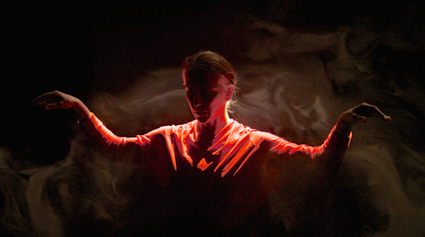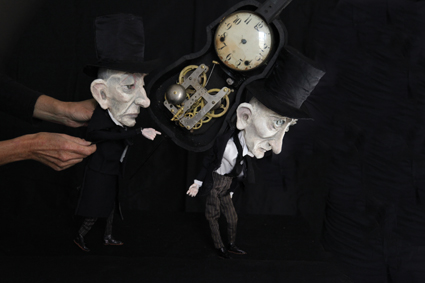Taking a fine brush to big ideas
John Bailey: Kate Hunter; Colleen Burke

Kate Hunter, Memorandum
photo Leo Dale
Kate Hunter, Memorandum
Some themes are so universal that they approach redundancy. When the author of a work states that its intended subject is identity or the body or place or consciousness there’s a very real risk of tautology, because there are so few works that don’t address every one of those broad notions in some sense. Navigating your way to the bathroom in the middle of the night does too. Doing something interesting with such grand notions is obviously a grand challenge itself, but sometimes the most effective method of painting big pictures is with a very fine brush.
Kate Hunter, Memorandum
Kate Hunter’s Memorandum concerns itself with one of the hoariest of topics, at least since mid-90s academia wrung every last drop from its cadaver. ‘Memory’ is the face that launched a thousand theses, perhaps second only to ‘desire’ in the empty signifier stakes, and there have been oceans of ink sacrificed by students justifying how (insert favourite text) is an exploration of memory’s vicissitudes. Proust did that, but someone has probably made a decent argument that Seinfeld did as well.
Hunter’s own performance history is one rich with promise. She’s a regular with physical theatre ensemble Born in a Taxi, has trained with Anne Bogart and Tadashi Suzuki’s SITI and her solo outings over various Melbourne Fringes have been engaging and well-received. She has a keen sense of the theatre as an embodied space and there’s a liveness to each of her performances that is likely a result of her work in improvised contexts.
But there’s a distinction between a work about memory and a work about a bunch of stuff that the artist remembers. Where once there was frequent lament over cultural amnesia, it now seems as if most lives are worthy of a memoir and any gaps in historical consciousness can simply be spackled over with the grey paste of a few childhood recollections.
Hunter’s narrative doesn’t rise above the memoir mode, but does trouble it in a way that ultimately bears fruit. Amid billowing clouds of smoke or overlaid with projected mirror images of her own form, or bouncing between layers of live and pre-recorded audio, she begins to lay out a narrative that commences in her own childhood but quickly dissolves into false memory, blatant fiction, recollection rendered in the second person, dream, speculation and commentary.
She names names, too: those of the youthful classmate who flashed his penis or the kid whose obvious poverty was made a laughing point, or the one who was chased down the street by a father brandishing a woodsplitter and threatening murder. Her adult self abruptly rounds a corner to face a man administering euthanasia with an axe head to a cow that has tumbled from a cliff. She has that awkward nocturnal encounter you have with a parent you’ve already buried in the ground and who is now asking for an explanation as to what the hell that was all about.
Perhaps the reason artists so often return to memory as a subject is that it is a thing of such stupid artifice. How dare we think that time can be arrested! The ego of it, the unfettered individualism, to think that those things we’ve lived through can be removed from the passage of natural decay and preserved by some private magic. From the inside, the memory of one person is close to all that there is of this world. Viewed from space, or even from the vantage point of a theatre seat in comfortable darkness—same thing, really— the same memory is as inconsequential as a breath.
But there’s not much life without breath. Hunter’s performance might not reveal a great deal about ‘memory’ and there’s an irony in the way that works about memory are themselves rarely memorable. But her words have that trained liveness, complemented by Richard Vabre’s sterling and deeply responsive lighting design, to allow each recollection a moment’s return. Hunter’s memories aren’t our own, and often may not even be hers, but rather than validating ‘memory’ there’s the possibility here that she’s paying respect to the dull and tiny inevitable death of everyone. Hunter doesn’t attempt to glorify her own recalled moments but treats them as subjects of curiosity, humour and sport.

Death at Intervals
photo Anna Malin
Death at Intervals
Colleen Burke, Death at Intervals
Death: that’s another one of those big and tiny subjects. Colleen Burke’s Death at Intervals balances its major and minor chords in unexpected ways. Liberally adapted from Jose Saramago’s As Intermitências da Morte, this puppetry work’s narrative delivers an unnamed nation in which death has inexplicably ceased—murders, accidents and even plane crashes leave their mutilated results still counted among the living, though not without resultant agony.
A lot depends on death, it turns out. Puncture the cycle and religion, politics, the economy and much more will suffer. Death at Intervals is less about the metaphysical implications of its premise and more about the socio-economic. At first we have only the moaning of funeral directors to put up with, but in time the wheezing almost-dead build up enough presence to force any audience member to wonder what would happen should cessation really cease. The zombie narrative is omnipresent today, but cauterise it of its violence and things actually get far more unsettling.
Burke’s adaptation bears obvious resonance with today’s Australia; the rising tide of the not-dead is used by a Prime Minister to justify a cruel and demanding new budget, while the fact that the bizarre situation is restricted to one nation establishes a xenophobic obsession with borders that is all too familiar.
Burke and fellow veteran puppeteer Frank Italiano incarnate a range of puppet styles in full audience view, themselves occasionally performing alongside, or instead of, their tiny charges. A character may be embodied by a long and lovingly detailed carving, or by the expert manipulation of little more than a hat. Some of the success here is due to director Rod Primrose of Handspan and Black Hole Theatre. Primrose’s eye for visual nuance and the changing character of the lit puppet are in full effect, but Burke’s puppet designs and performance are the most notable stars.
When Death returns, she is a wonder. A silver-grey skull atop a twisted spine and skeletal hand, she is a puppet of rare ingenuity, straddling the mimetic and abstract, functional and ornate. She happens upon a cellist and becomes variously fascinated and repulsed by him, and the strange conclusion, in which death attains a kind of love, is as mysterious and ephemeral as the exhalation that accompanies its final image. A sigh, a gasp, a death rattle? But this is not a work that looks to answer questions big or small, and is all the more satisfying for it.
Memorandum, creation, audio design, performance, Kate Hunter, Theatre Works, 20 May-1 June; Death at Intervals, creation Colleen Burke, performers Colleen Burke, Frank Italiano, director Dave Evans, La Mama Courthouse, Melbourne, May 14-25
RealTime issue #121 June-July 2014 pg. 42






